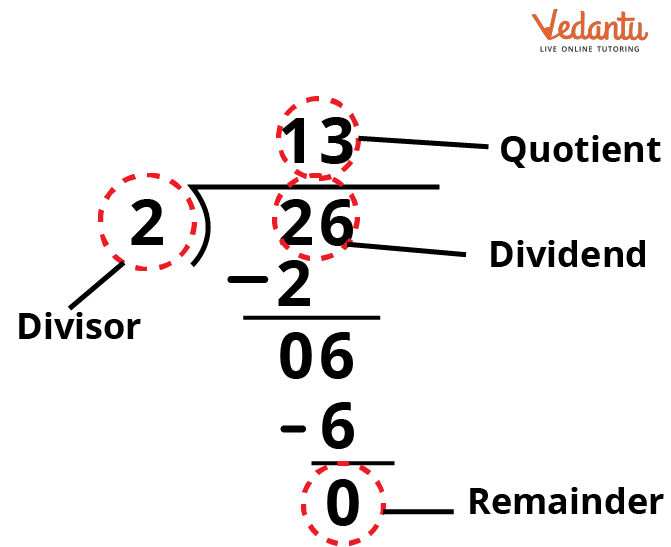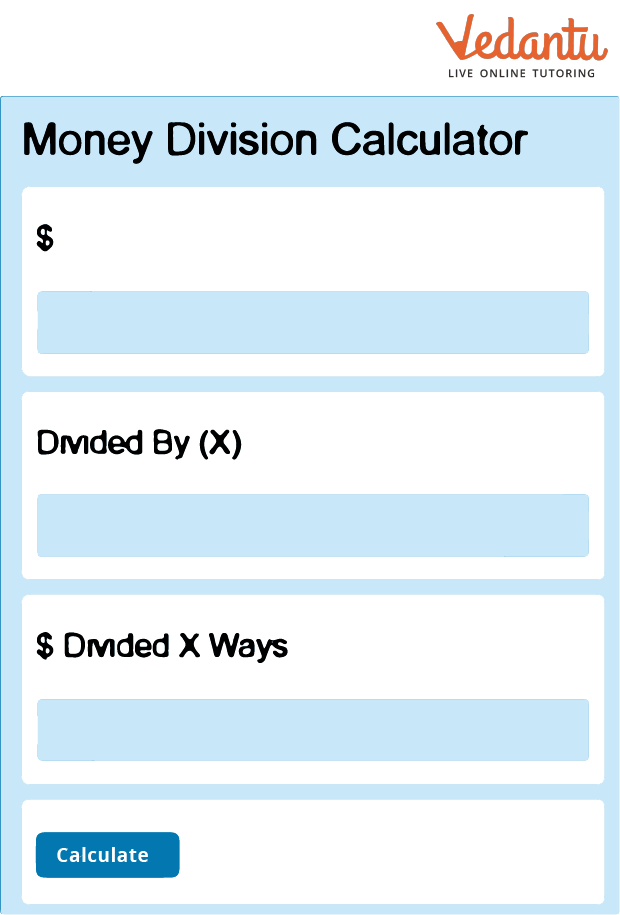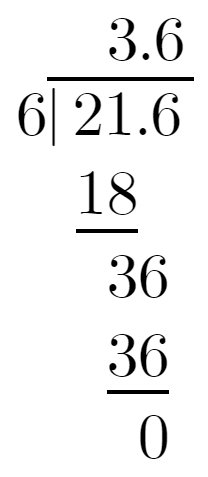




Step-by-Step Money Division: Solving Practical Questions
Because it increases the amount, money division is less enjoyable to think about as money addition or multiplication. After all, most of us would choose to increase our income over dividing it. However, the capacity to divide the money is an important skill for good money management. It helps us calculate things like the cost of an item per ounce or a good.

Division of Money
What is Division?
The basic purpose of the division is to produce equal groups or to verify how many individuals are in each category following a fair distribution.
The four main parts of division are the dividend, the divisor, the quotient, and the remainder. Every day, we use the division approach in various situations.
How Division Works
Let's start by splitting some numbers; it's not that difficult. Remember to fit the decimal points in the dividend, and the quotient is, by far, the most important factor.
When you are dividing to calculate the unit cost of something or anything else that could create a rupee value, remember the rupee symbol first. Second, you don't need to divide money amounts by more than three decimal places because we can't pay in fractions of paisa. Using three decimal places serves the primary task of providing that we know whether to round up or down.

Parts of Division
Money Divider Calculator
Long division is used to divide a given sum of money into an exact number of equal individual units, known as money division.
To divide the money, enter any amount of money and the number you want to divide it into the calculator. Given the other factors, this calculator can also calculate either the initial sum or the total number of divisions.

Money Calculator
The formula used to calculate money division is $MD = \dfrac{D}{X}$.
Where MD has divided the money, D is the original amount, and X is the number to divide with.
Examples of Money Division
Let us look at some money division examples:
Example 1: Find the quotient.
$5\overline{)626.63}$
Solution:
We need to find the quotient when 626.63 is divided by 5.
We will perform the long division,

626.63/5
The quotient obtained by dividing 626.63 by 5 is 125.326.
As there cannot be more than 2 digits after the decimal, then we will have to round off the decimal places. On rounding off, we get 125.33.
Therefore, on performing long division on 626.63 by 5, the quotient we get is 125.33.
Example 2: Find the quotient.
$5\overline{)3,295.15}$
Solution:
We need to find the quotient when 3,295.15 is divided by 2.
We will perform the long division,

3295.15/2
The quotient obtained by dividing 3,295.15 by 2 is 1,647.575.
As there cannot be more than 2 digits after the decimal, then we will have to round off the decimal places. On rounding off, we get 1,647.58.
Therefore, on performing long division on 3,295.15 by 2, the quotient we get is 1,647.58.
Example 3: Find the quotient:
$7\overline{)2,341.92}$
Solution:
We need to find the quotient when 2,341.92 is divided by 7.
We will perform the long division,

2341.92/7
Therefore, on performing the long division on 2,341.15 by 7, the quotient we get is 334.56.
Dividing Money Worksheets
Do your children realise who gets the money worksheet's free answer key? You people, of course! So, let’s get started:
Q1: Find the quotient:
$6\overline{)21.6}$
Solution:
We need to find the quotient when 21.6 is divided by 6.
We will perform the long division,

21.6/6
On performing the long division on 21.6 by 6, the quotient is 3.6.
Q2: Find the quotient:
$6\overline{)82.74}$
Solution:
We need to find the quotient when 82.74 is divided by 6.
We will perform the long division,

82.74/6
On performing the long division on 82.74 by 6, the quotient is 13.79.
Q3: Sima was asked to distribute ₹942.12 to 9 of her classmates. How much will each one of her classmates receive in terms of money?
Solution:
To divide ₹942.12 among 9 of Sima’s classmates.
We will have to perform the long division,

942.12/9
Dividing ₹942.12 among 9 of Sima’s classmates is ₹104.68.
Q4: Simba bought five chocolates for ₹56.25. How much does one chocolate cost?
Solution:
From the given question,
The cost of 5 chocolates is ₹56.25.
To find the cost of 1 chocolate, we will have to perform a long division where ₹56.25 is divided by 5 chocolates.

56.25/5
The cost of 1 chocolate that Simba bought is ₹11.25.
Conclusion
In this article, we have learned about the basic arithmetic operation, i.e. division. The division is used to distribute things equally. Division breaks down a large group into smaller parts. Division can also be separated into two parts, areas or groups. Every arithmetic operation has its unique symbol. In division, the sign is ‘÷’ or ‘/’ or ‘_’.
FAQs on Money Division Explained: Concepts and Real-Life Uses
1. What exactly is money division and why is it a useful skill to learn?
Money division is the process of splitting a total amount of money into a specific number of equal parts. It is a very useful skill in daily life because it helps us to manage our finances fairly and accurately. For example, it is used for budgeting pocket money, sharing the cost of a meal with friends, or figuring out the price of a single item when you buy a pack of them.
2. Can you provide some real-life examples of how we use money division?
Certainly. We use money division in many common situations. Here are a few examples:
Splitting a Bill: If you and 3 friends have a meal that costs ₹400, you would divide 400 by 4 to find out that each person needs to pay ₹100.
Shopping: If a pack of 5 chocolate bars costs ₹50, you can divide 50 by 5 to determine that the cost of one chocolate bar is ₹10.
Saving Money: If you want to save ₹200 in 4 weeks, you divide 200 by 4 to know that you need to save ₹50 each week.
3. What are the key parts of a money division problem?
Every money division problem has three main parts:
The Dividend: This is the total amount of money that you are starting with and want to divide (e.g., ₹100).
The Divisor: This is the number of equal groups you are dividing the money into (e.g., 5 people).
The Quotient: This is the answer, or the amount of money in each group after dividing (e.g., ₹20 per person).
4. How do you solve a simple money division word problem?
To solve a money division word problem, follow these simple steps. For example, if 'Ria and her two friends want to share ₹30 equally':
1. Identify the total money (Dividend): The total amount is ₹30.
2. Identify the number of groups (Divisor): There is Ria plus two friends, which makes 3 people in total.
3. Perform the division: Divide the dividend by the divisor. So, ₹30 ÷ 3 = ₹10.
The answer (quotient) is that each person gets ₹10.
5. Why is learning to divide money so important for ensuring fairness?
Learning to divide money is crucial for fairness because it ensures that everyone in a group pays or receives their exact and equal share. Without division, it would be difficult to split costs or share prize money correctly, which could lead to disagreements. For instance, when contributing to a group gift, division guarantees that no single person unfairly pays more or less than others.
6. What happens if an amount of money cannot be divided equally among a group?
This is a great question and happens often in real life. When money cannot be divided perfectly, you are left with a remainder. For example, if 3 friends try to share ₹10, each would get ₹3 (3 x 3 = 9), but there would be ₹1 left over. This leftover amount can be handled in different ways: it could be given to one person, saved for later, or donated.
7. How is dividing money different from dividing physical objects like pencils?
The main difference is that money is designed to be divisible into smaller units (like rupees into paise), which makes it easier to share precisely. You can divide ₹5 between two people to get ₹2.50 each. However, you cannot divide 5 physical pencils between two people without breaking one. This shows that money division allows for fractions or decimals in the answer, while dividing whole objects often results in a remainder if the division is not exact.















